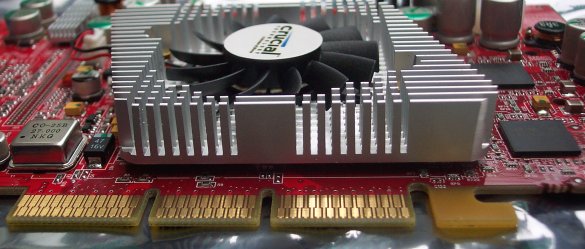Card I
Hercules have shown that not all Radeon 9800s need look the same. Hercules' blue PCB and hunks of copper gave it an individual look. Crucial have never been one to stray too far off the generic ATi reference design.
You won't be surprised to learn that this is about as generic as one could possibly get, save for the token Crucial sticker on the GPU's fan. Is adhering to the reference design such a bad thing ?. It should keep costs down, guarantee smooth running, and be widely available. In fact, we're adamant that all Crucial do is stick its own name on and market it as a Crucial 9800 Pro. That's not a real criticism, though, as there's little wrong with stick to a proven design.

We might just run a spot-the-difference competition between this and the reference card that was reviewed a few months ago. You'll do well to pick up more than 5 differences. Again, that's just us being a little underwhelmed by cards that appear to be so similar on the surface.

The Radeon 9800 doesn't look all that different from the card that really started ATi's ball rolling, the 9700 Pro. However, the cooler has seen an upgrade in the intervening period between cards. A 380MHz core, based on the same manufacturing process as the 325MHz 9700 Pro's, needs a little extra help in dissipating heat. Crucial opt for the aluminium cooler and pitched fins approach of the reference design. One word about noise, well, maybe a few words; the fan makes an irritatingly loud whir when switched on, and unlike the newest NVIDIA cards the GPU cannot be set to independent levels for either 2D or 3D work. We now wish that ATi had implemented some from of clock and fan control. Therefore, if you're looking for the quietest of systems, the 9800 Pro's fan may just put you off a little. Of course, you could always attach one of the groovy Zalman noiseless heatsink combinations.

A standard MOLEX plug is a necessary evil for today's high-end cards. Its job is to draw enough power from the PSU to ensure flawless running. Crucial provide a MOLEX pass-through in the bundle. The standard 9800s are impressive cards but sometimes leave a little to be desired from the video-editing front.

The back's pretty regular for any modern card. HD15 on the left, S-Video (TV-Out) in the middle and DVI on the right. It may sound as if we're being ultra-critical here, and the following statement is not aimed at the Crucial card in particular, but we'd appreciate a twin DVI version of the card. Running two TFTs isn't as daft as it may sound, and once you've sampled the delights and clarity of a digital connection, you'd be loathed to run a secondary display via the inferior analogue signal.









